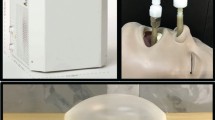Abstract
Percutaneous image-guided thermal ablation of tumor is widely used, and thermal injury to collateral structures is a known complication of this technique. To avoid thermal damage to surrounding structures, several protection techniques have been reported. We report the use of a simple and effective protective technique combining carbon dioxide dissection and thermocouple: CO2 displaces the nontarget structures, and its low thermal conductivity provides excellent insulation; insertion of a thermocouple in contact with vulnerable structures achieves continuous thermal monitoring. We performed percutaneous thermal ablation of 37 tumors in 35 patients (4 laser, 10 radiofrequency, and 23 cryoablations) with protection of adjacent vulnerable structures by using CO2 dissection combined with continuous thermal monitoring with thermocouple. Tumor locations were various (19 intra-abdominal tumors including 4 livers and 9 kidneys, 18 musculoskeletal tumors including 11 spinal tumors). CO2 volume ranged from 10 ml (epidural space) to 1500 ml (abdominal). Repeated insufflations were performed if necessary, depending on the information given by the thermocouple and imaging control. Dissection with optimal thermal protection was achieved in all cases except two patients where adherences (one postoperative, one arachnoiditis) blocked proper gaseous distribution. No complication referred to this technique was noted. This safe, cost-effective, and simple method increases the safety and the success rate of percutaneous thermal ablation procedures. It also offers the potential to increase the number of tumors that can be treated via a percutaneous approach.





Similar content being viewed by others
References
Boss A, Clasen S, Kuczyk M et al (2005) Thermal damage of the genitofemoral nerve due to radiofrequency ablation of renal cell carcinoma: a potentially avoidable complication. AJR Am J Roentgenol 185:1627–1631
Nakatsuka A, Yamakado K, Takaki H et al (2008) Percutaneous radiofrequency ablation of painful spinal tumors adjacent to the spinal cord with real-time monitoring of spinal canal temperature: a prospective study. Cardiovasc Intervent Radiol [Epub ahead of print]
Laeseke PF, Sampson LA, Brace CL et al (2006) Unintended thermal injuries from radiofrequency ablation: protection with 5% dextrose in water. AJR Am J Roentgenol 186:S249–S254
Chen EA, Neeman Z, Lee FT et al (2006) Thermal protection with 5% dextrose solution blanket during radiofrequency ablation. Cardiovasc Intervent Radiol 29:1093–1096
Gangi A, Alizadeh H, Wong L et al (2007) Osteoid osteoma: percutaneous laser ablation and follow-up in 114 patients. Radiology 242:293–301
Buy X, Basile A, Bierry G et al (2006) Saline-infused bipolar radiofrequency ablation of high-risk spinal and paraspinal neoplasms. AJR Am J Roentgenol 186:S322–S326
Diehn FE, Neeman Z, Hvizda JL, Wood BJ (2003) Remote thermometry to avoid complications in radiofrequency ablation. J Vasc Interv Radiol 14:1569–1576
Yamakado K, Nakatsuka A, Akeboshi M, Takeda K (2003) Percutaneous radiofrequency ablation of liver neoplasms adjacent to the gastrointestinal tract after balloon catheter interposition. J Vasc Interv Radiol 14:1183–1186
Kam AW, Littrup PJ, Walther MM et al (2004) Thermal protection during percutaneous thermal ablation of renal cell carcinoma. J Vasc Interv Radiol 15:753–758
Dupuy DE, Hong R, Oliver B, Goldberg SN (2000) Radiofrequency ablation of spinal tumors: temperature distribution in the spinal canal. AJR Am J Roentgenol 175:1263–1266
Bruners P, Hodenius M, Gunther RW et al (2007) Fluid-modulated RF ablation: in-vitro experiments. Rofo 179:380–386
Kerns SR, Hawkins IF Jr (1995) Carbon dioxide digital subtraction angiography: expanding applications and technical evolution. AJR Am J Roentgenol 164:735–741
Shaw DR, Kessel DO (2006) The current status of the use of carbon dioxide in diagnostic and interventional angiographic procedures. Cardiovasc Intervent Radiol 29:323–331
Haaga JR, Beale SM (1986) Use of CO2 to move structures as an aid to percutaneous procedures. Radiology 161:829–830
Raman SS, Aziz D, Chang X et al (2004) Minimizing diaphragmatic injury during radiofrequency ablation: efficacy of intraabdominal carbon dioxide insufflation. AJR Am J Roentgenol 183:197–200
Kariya S, Tanigawa N, Kojima H et al (2005) Radiofrequency ablation combined with CO2 injection for treatment of retroperitoneal tumor: protecting surrounding organs against thermal injury. AJR Am J Roentgenol 185:890–893
Lantz PE, Smith JD (1994) Fatal carbon dioxide embolism complicating attempted laparoscopic cholecystectomy—case report and literature review. J Forensic Sci 39:1468–1480
Author information
Authors and Affiliations
Corresponding author
Rights and permissions
About this article
Cite this article
Buy, X., Tok, CH., Szwarc, D. et al. Thermal Protection During Percutaneous Thermal Ablation Procedures: Interest of Carbon Dioxide Dissection and Temperature Monitoring. Cardiovasc Intervent Radiol 32, 529–534 (2009). https://doi.org/10.1007/s00270-009-9524-8
Received:
Revised:
Accepted:
Published:
Issue Date:
DOI: https://doi.org/10.1007/s00270-009-9524-8




